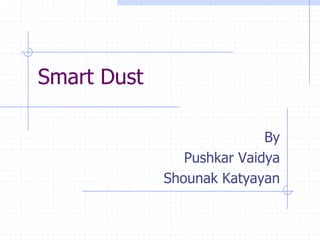Smart dust
- 1. Smart Dust By Pushkar Vaidya Shounak Katyayan
- 2. SAND / DUST Components that are found EVERYWHERE Land Air Water Human Body
- 3. Feature of DUST Very Small Found Anywhere Blown away Light in weight Remain suspended in air
- 4. Smart Dust Smart Dust is a nano structured silicon sensor based on Particle Science, supporting VLSI that can spontaneously gather and relay information on the local environment
- 5. Sensors Humidity Temperature Pressure Acceleration Light Magnetometer
- 6. Components
- 7. 2008 Kristofer S. J. Pister 2001
- 8. Progress
- 9. Cost Silicon $0.30 Inductor $0.01 Crystal $0.15 Battery $0.16 Total : $0.62 approx. Rs. 30/chip
- 10. Applications Environmental Protection Radiation Containments in water Disaster Habitat Monitoring Animals Military Applications Detect presence of Enemy troops Medical Applications Detect Damaged Cells And Many OthersâĶ
- 13. Links http://www.facstaff.bucknell.edu/mvigeant/univ270_05/EmilyBeeing/Methods.html http://www.cbsnews.com/stories/2003/08/25/tech/main570080.shtml http://en.wikipedia.org/wiki/Smartdust http://berkeley.edu/news/media/releases/2001/05/25_dust.html http://computer.howstuffworks.com/mote2.htm http://robotics.eecs.berkeley.edu/~pister/ http://www.redicecreations.com/specialreports/smartdustmatrix.html
Editor's Notes
- The idea of smart dust was first introduced in the year 2001On left we can see him holding the first modules of the smart dust(chips) while in the other picture he is holding highly integrated motes













